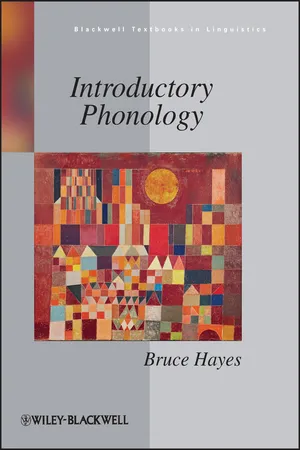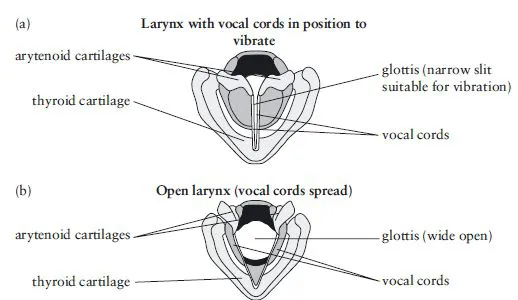
- English
- ePUB (mobile friendly)
- Available on iOS & Android
eBook - ePub
Introductory Phonology
About this book
Accessible, succinct, and including numerous student-friendly features, this introductory textbook offers an exceptional foundation to the field for those who are coming to it for the first time.
- Provides an ideal first course book in phonology, written by a renowned phonologist
- Developed and tested in the classroom through years of experience and use
- Emphasizes analysis of phonological data, placing this in its scientific context, and explains the relevant methodology
- Guides students through the larger questions of what phonological patterns reveal about language
- Includes numerous course-friendly features, including multi-part exercises and annotated suggestions for further reading at the end of each chapter
Frequently asked questions
Yes, you can cancel anytime from the Subscription tab in your account settings on the Perlego website. Your subscription will stay active until the end of your current billing period. Learn how to cancel your subscription.
No, books cannot be downloaded as external files, such as PDFs, for use outside of Perlego. However, you can download books within the Perlego app for offline reading on mobile or tablet. Learn more here.
Perlego offers two plans: Essential and Complete
- Essential is ideal for learners and professionals who enjoy exploring a wide range of subjects. Access the Essential Library with 800,000+ trusted titles and best-sellers across business, personal growth, and the humanities. Includes unlimited reading time and Standard Read Aloud voice.
- Complete: Perfect for advanced learners and researchers needing full, unrestricted access. Unlock 1.4M+ books across hundreds of subjects, including academic and specialized titles. The Complete Plan also includes advanced features like Premium Read Aloud and Research Assistant.
We are an online textbook subscription service, where you can get access to an entire online library for less than the price of a single book per month. With over 1 million books across 1000+ topics, we’ve got you covered! Learn more here.
Look out for the read-aloud symbol on your next book to see if you can listen to it. The read-aloud tool reads text aloud for you, highlighting the text as it is being read. You can pause it, speed it up and slow it down. Learn more here.
Yes! You can use the Perlego app on both iOS or Android devices to read anytime, anywhere — even offline. Perfect for commutes or when you’re on the go.
Please note we cannot support devices running on iOS 13 and Android 7 or earlier. Learn more about using the app.
Please note we cannot support devices running on iOS 13 and Android 7 or earlier. Learn more about using the app.
Yes, you can access Introductory Phonology by Bruce Hayes,Bruce P. Hayes in PDF and/or ePUB format, as well as other popular books in Languages & Linguistics & Phonetics & Phonology. We have over one million books available in our catalogue for you to explore.
Information
1
Phonetics
1.1 Phonetics and Phonology
There are two branches of linguistic science that deal with speech sounds: phonetics and phonology.
Phonetics is primarily an experimental science, which studies speech sounds from three viewpoints:
- Production: how sounds are made in the human vocal tract
- Acoustics: the study of the waveforms by which speech is transmitted through the atmosphere
- Perception: how the incoming acoustic signal is processed to detect the sound sequence originally intended by the speaker
Phonology is also, sometimes, an experimental science, though it also involves a fair degree of formal analysis and abstract theorizing. The primary data on which phonological theory rests are phonetic data, that is, observations of the phonetic form of utterances. The goal of phonology is to understand the tacit system of rules that the speaker uses in apprehending and manipulating the sounds of her language (more on this in chapter 2).
Since phonological data are phonetic, and since (as we will see) the very nature of phonological rules depends on phonetics, it is appropriate for beginning students to study phonetics first. In particular, a phonologist who tries to elicit data from native speakers without prior training in the production and perception of speech sounds will be likely to have a hard time. The material that follows can be taken to be a quick review of phonetics, or else a very quick introduction that can be amplified with reading and practical training from materials such as those listed at the end of the chapter.
In principle, a phonologist should understand all three of the areas of phonetics listed above: production, acoustics, and perception. Of these, production probably has the greatest practical importance for the study of phonology. Since it is also the simplest to describe, it is what will be covered here.
1.2 The Vocal Tract
The term “vocal tract” designates all the portions of the human anatomy through which air flows in the course of speech production (see figure 1.1). These include (from bottom to top):
- The lungs and lower respiratory passages
- The larynx (colloquially: “voice box”). This is the primary (but not the only) source of sound in speech production
- The passages above the larynx, called the pharynx, oral cavity (mouth), and nasal cavity

Figure 1.1 The vocal tract
The lungs and respiratory muscles produce a fairly steady level of air pressure, which powers the creation of sound. There are occasional momentary peaks of pressure for certain speech sounds and for emphatically stressed syllables. Air from the lungs ascends through the bronchial tubes, which join to form the trachea (windpipe). The bronchial tubes and the trachea form an inverted Y-shape.
1.2.1 The larynx
The larynx is a complex structure of cartilage and muscle, located in the neck and partly visible in adult males (whose larynxes are the largest) as the “Adam’s apple.” Figure 1.2 shows two diagrams of the larynx:

Figure 1.2 The larynx
The larynx contains the vocal cords (not “chords”), which are parallel flaps of tissue extending from each side of the interior larynx wall. The vocal cords have a slit between them, called the glottis. The vocal cords are held at their rear ends by two small cartilages called the arytenoid cartilages. Since these cartilages are mobile, they can be used to adjust the distance between the vocal cords.
When the vocal cords are held tightly together, the sound known as a glottal stop is produced; it can be heard in the middle of the expression “uh-oh” and is used as a speech sound in many languages.
If the vocal cords are placed close to each other but not tightly shut, and there is sufficient airflow from the lungs, then the vocal cords will vibrate, creating voicing. This is the configuration shown in figure 1.2(a). Voicing is the most important and noticeable sound source in speech.
The vocal cords can also be spread somewhat apart, so that air passing through the glottis creates turbulent noise. This is the way an “h” sound is produced. The vocal cords are spread farther still for normal breathing, in which airflow through the larynx is smooth and silent. This is the configuration shown in figure 1.2(b).
The cartilages of the larynx, especially the thyroid cartilage to which the front ends of the vocal cords attach, can stretch and slacken the vocal cords, thus raising and lowering the pitch of the voice. This is some...
Table of contents
- Cover
- Table of Contents
- Blackwell Textbooks in Linguistics
- Title
- Copyright
- Dedication
- Preface
- 1: Phonetics
- 2: Phonemic Analysis
- 3: More on Phonemes
- 4: Features
- 5: Morphology
- 6: Phonological Alternation I
- 7: Phonological Alternation II
- 8: Morphophonemic Analysis
- 9: Productivity
- 10: The Role of Morphology and Syntax
- 11: Diachrony and Synchrony
- 12: Abstractness
- 13: Syllables
- 14: Stress, Stress Rules, and Syllable Weight
- 15: Tone and Intonation
- Appendix: On Phonology Problems
- Index
- End User License Agreement